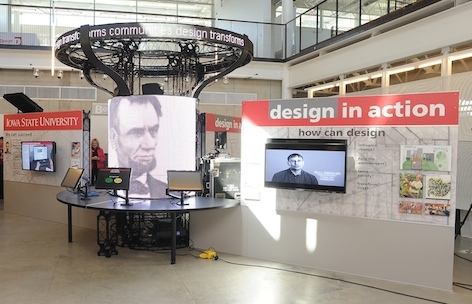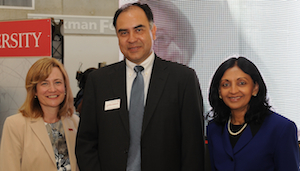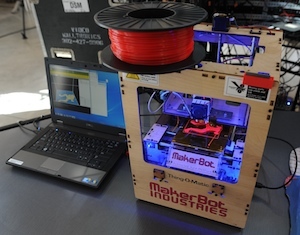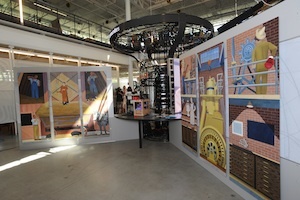
AMES, Iowa -- More than 1 million people are expected to visit the Smithsonian Folklife Festival on the National Mall in Washington, D.C., June 27- July 1 and July 4-8. And Iowa State University will be center stage to show how faculty, staff and students put design in action to transform communities.
Last year, Iowa State's proposal from the College of Design and ISU Extension and Outreach was one of only 17 selected to represent land-grant universities in the 2012 festival's celebration of the 150th anniversary of the signing of the Morrill Act — which laid the foundation for land grants — and the creation of the U.S. Department of Agriculture.

Cathann Kress, vice president for extension and outreach; Luis Rico-Gutierrez, design college dean; and Chitra Rajan, associate vice president for research led the project for Iowa State.
A dedicated team of faculty, staff and students has been hard at work since then, creating the university's exhibit, "Transforming Communities: Design in Action." A campus preview was held today (June 12) before the trusses, computers, LED panels, touchscreen workstations and original artwork are crated and shipped to the nation's capital later this week.
Iowa State's exhibit is part of the Festival's 2012 program, "Campus and Community: Land-grant Universities and the USDA at 150," and is the only one that features the central role of design in the land-grant mission. Iowa State's unique, ongoing partnership between the College of Design and Extension and Outreach enables faculty, staff and students to apply design thinking to help communities solve problems.Inaugurated in 1967 as an international exposition of living cultural history, the Smithsonian Folklife Festival has brought more than 23,000 musicians, artists, performers, craftspeople and storytellers to the National Mall to demonstrate the skills, knowledge and aesthetics that embody the creative vitality of community-based traditions.

Exhibit includes a tabletop MakerBot to produce 3D objects.
Blending the advanced and the old-fashioned
Iowa State's exhibit uses a blend of advanced, interactive technology and old-fashioned personal conversation to demonstrate the techniques and processes designers use to create, innovate and transform communities.
The skeleton of the T-shaped exhibit is a powder-coated, steel-truss system 26-feet wide. The 1,340-pound truss structure holds an array of LED panels, computerized controllers, traditional display boards, video monitors, interactive workstations and paintings.
One side of the exhibit will be loaded with technology, while the other side will host personal, interactive activities, demonstrations and mini-workshops.
Digital exhibit features
- At the high-tech center of the exhibit, a column of LED panels will show video of people answering questions about design.
- Four touchscreen workstations for interactive games will allow visitors to explore the world of design and think like designers.
- Staff using iPads will relay visitors' ideas for display on the circular ribbon-board LED crawl that tops the column.
- An audio-visual light signal will travel in pulses up the column to announce that a visitor has a new idea.
- Two flat screen monitors will show a video about more than 50 projects in 30 towns to tell how Iowa State's collaboration between design and extension impacts communities. Images of students' studio class projects envision innovative options for the future.
- Iowa State's exhibit is inspired by Abraham Lincoln’s 1862 call for the nation to "think anew and act anew" to solve the monumental challenges of the time. A motion-activated recording will play the full quote read by Simon Estes, an internationally acclaimed bass-baritone and ISU adjunct professor of music and theater.
- Exhibit staff will demonstrate how designers use technology like a MakerBot to create prototypes and models. A MakerBot is a 3D printer that uses thermoplastic extrusion to make 3D objects.
Analog exhibit features

Visitors can reinterpret Grant Wood mural panels with painted magnets.
- Jennifer Drinkwater, an integrated studio arts lecturer, will replicate her Morrill Hall interactive studio project, "Working Over Wood: Recomposing the Grant Wood Murals." Visitors can help recompose panels from the 1934 Grant Wood mural, "When Tillage Begins, Other Arts Follow." Drinkwater recreated the mural on steel panels, allowing participants to position painted magnetic pieces to reflect their own interpretations. The project celebrates and calls attention to the fine arts on Iowa State's campus.
- Arthur Croyle, associate professor of integrated studio arts, will chronicle the festival, creating plein air watercolor sketches of the exhibit, visitors and the Mall's historic buildings.
- Extension staff and design faculty will lead visitors through interactive design charrettes (intense, collaborative design activities in which people brainstorm, discuss and draft solutions to a design problem), which are used in Iowa State's community projects to bring people and ideas together to focus on problem solving.
- Faculty and students will lead visitors in games and activities that allow them to exercise their own creativity.
- Three student projects selected in a competition to design an interactive feature for the exhibit will be on display. Each is a human-scale machine that measures some kind of phenomenon (light, wind, sound, etc.), engages the body, uses mostly recycled materials, and demonstrates the process of design thinking.
The "Transforming Communities: Design in Action" exhibit also will be part of the university's exhibit in the Varied Industries Building at the Iowa State Fair, Aug 9-19, and one of the Iowa State University Extension and Outreach exhibits at the Farm Progress Show, Aug. 28-30.
Iowa State's project was led by Chitra Rajan, associate vice president for research; Cathann Kress, vice president for extension and outreach; and Luis Rico-Gutierrez, dean of the design college. Sandra Norvell, Center for Excellence in the Arts and Humanities, coordinated the project development. David Ringholz, associate professor and chair of industrial design, led the exhibit design team. Lisa Fontaine, associate professor of graphic design, led the exhibit content team. Information Technology Services provided technical assistance.